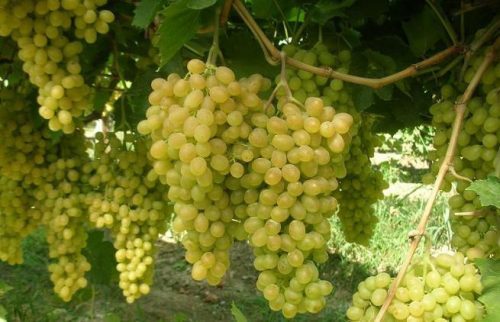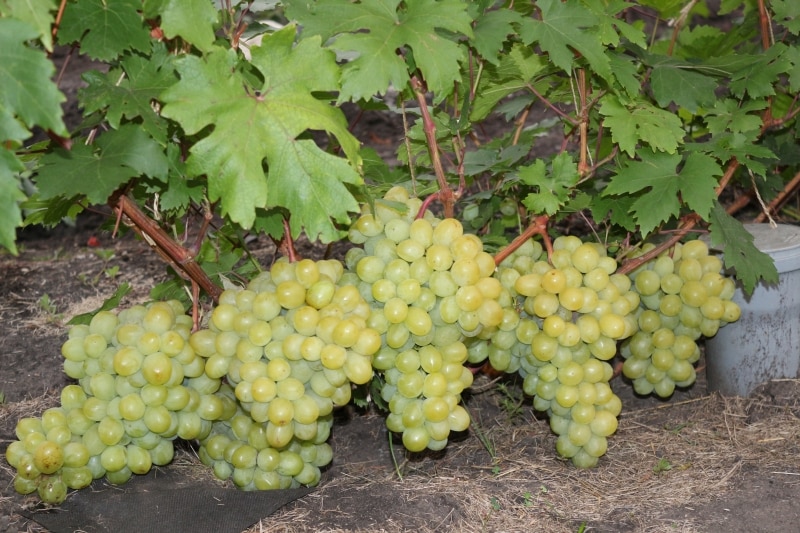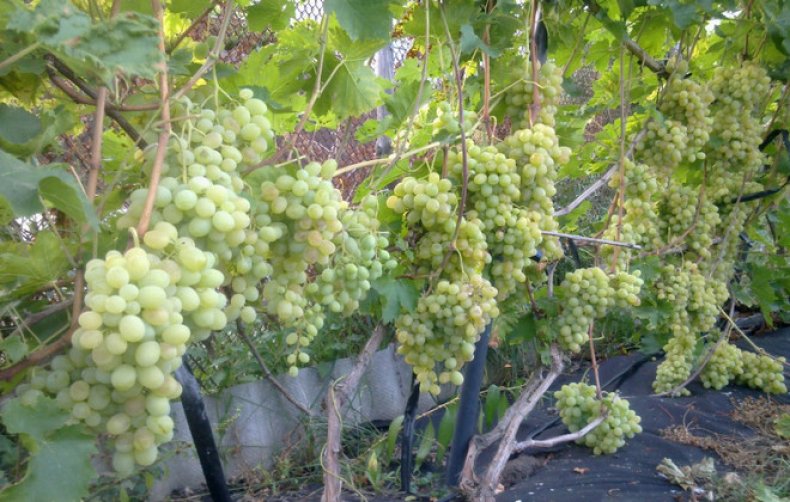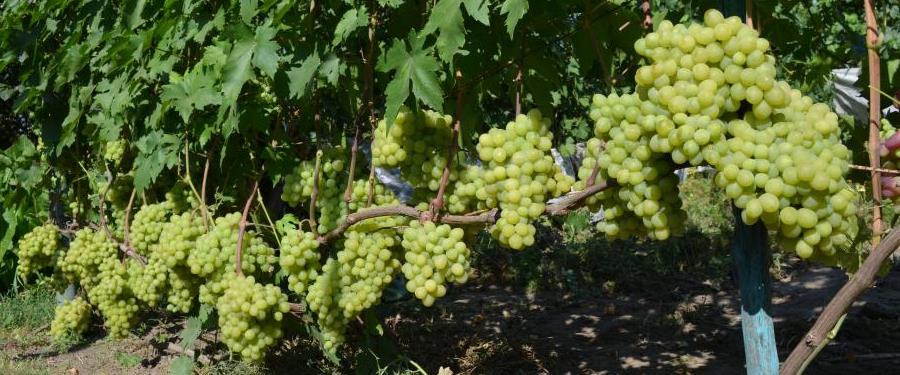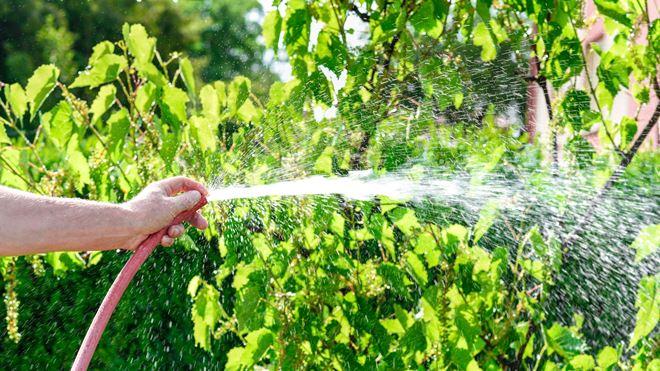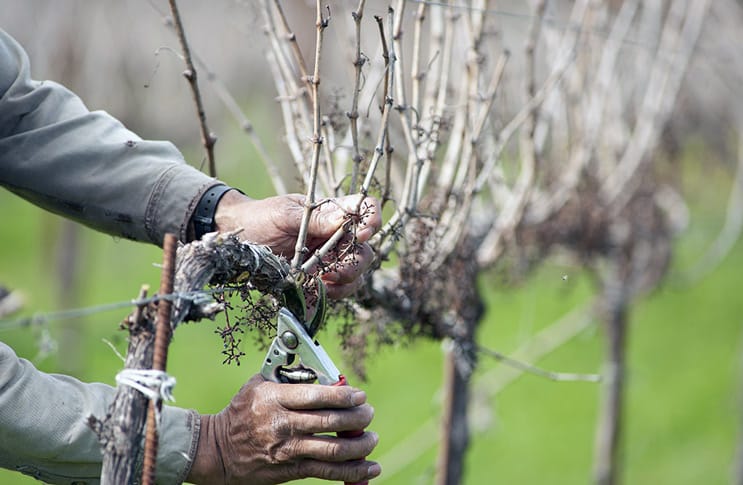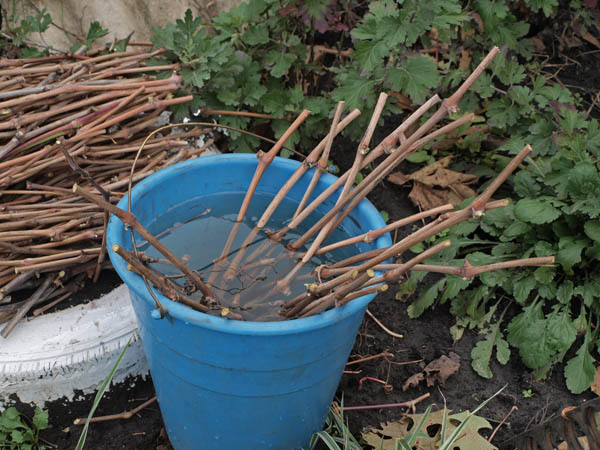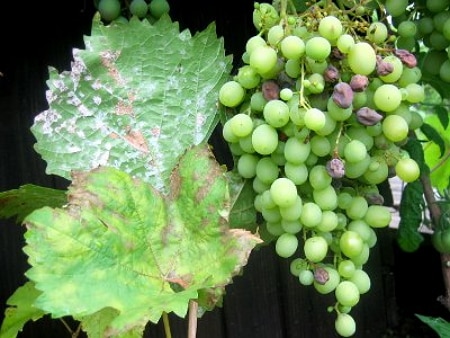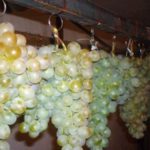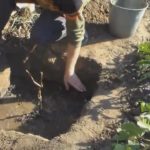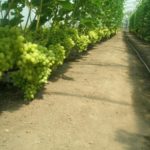Warm-loving crops have long been a fixture on the plots of gardeners living in regions with a changeable climate. This became possible thanks to the development of new varieties and hybrids with high frost resistance and immunity to diseases. Until recently, it seemed impossible to grow large and sweet grapes in the middle zone. However, today it is quite possible if you choose the right variety. Valek grapes have many fans both among summer residents who grow the crop for the needs of their families, and among large farms engaged in cultivating vines on an industrial scale.
- History of selection and characteristics of the variety
- Frost resistance and disease resistance
- Beginning of fruiting and amount of harvest
- Taste qualities of berries
- Transportability and shelf life of the crop
- Biological description
- Bushes and shoots
- Berries and bunches
- Growing
- Landing
- Soil care
- Watering and fertilizing
- Support
- Pinching and trimming
- Cold protection
- Reproduction methods
- Diseases to which the variety is susceptible
- Oidium
- Mildew
- Pests
- Prevention of diseases and pests of grapes
History of selection and characteristics of the variety
Experiments in the field of selection are carried out not only by scientists, but also by amateurs. And sometimes the latter manage to create hybrids that are in no way inferior to the work of professionals. One of the most successful developments of an amateur from the Kirovograd region Vishnevetsky N.P. was the Valek grape variety. Initially, it was bred for cultivation in the climatic conditions of Ukraine, but has long overcome geographical boundaries and has become a favorite of Russian gardeners.
The hybrid was based on several varieties: Rizamat, Kesh 1 and Zvezdny. Valek took all the best characteristics from his parents.
Frost resistance and disease resistance
Hybrid Valek can withstand winter temperatures down to -25 degrees. However, experienced winegrowers still advise 1-2 year old seedlings to be insulated for the winter. Valek's immunity to vine diseases is above average, which simplifies the process of caring for the bushes. It is enough to carry out preventive measures in time to ensure that the vine is healthy and produces the declared yields. Fungal diseases and various types of rot do not often affect the hybrid.
Beginning of fruiting and amount of harvest
Hybrid Valek belongs to the early-ripening varieties. Already in early August, gardeners in the southern regions pick the first berries.In colder climates, ripening will take a little longer; the first clusters will ripen by the end of the last summer month. The manufacturer's description indicates a period of 105 days.
Gardeners growing Valek on their plots note the high yield of the hybrid.
In a good year, up to 30 kg of berries are harvested from one bush. The weight of one brush can reach 2 kg with proper agricultural technology and a suitable climate. Valek grapes begin to bear fruit already in the second year after planting.
Taste qualities of berries
Taste is the main advantage of a hybrid, for which gardeners love it. Large yellowish-green berries are very sweet and tasty. And although the fruits have a thick skin, it does not spoil the taste of the grapes; they are just as tasty and sweet.
The weight of one berry reaches 18 grams. The pulp is dense; when you bite into it, you feel a light nutmeg aroma and pear flavor.
Transportability and shelf life of the crop
The bunches of Valek grapes can easily be transported over long distances, which makes it possible to grow them for sale. During storage, the berries do not crack, do not rot, and do not lose their taste. In a properly equipped room, the fruits can be stored for up to 3 months.
Biological description
Not only the taste characteristics attract gardeners, but also the appearance of the vine. Valek is one of the most beautiful hybrids that will decorate the site.
Bushes and shoots
The bushes of the Valek vine are vigorous, strong, and are not afraid of gusts of wind. The shoots are highly developed and grow quickly. The young vine has time to fully ripen during the summer. If pruning is not done in time, the bush can grow quite wide.
Berries and bunches
Huge cone-shaped clusters are one of the main advantages of the hybrid.Despite the high density of the cluster, the berries are not damaged, they have time to ripen during the summer period and do not crack even in rainy summers.
Growing
A gardener can evaluate all these characteristics only if planting and care are carried out correctly. There is nothing difficult in the process of growing Valek. It needs standard agrotechnical measures - a suitable place, watering and fertilizing, pruning and shaping the vine, preventing diseases and pests.
Landing
When planning to plant Valek on your site, it is worth considering his love of space:
- Its root system grows greatly both in depth and in width, so the distance between young seedlings should not be less than 3 meters.
- If you plan to plant several rows, then maintain a distance of 4 meters between them.
- The depth of the planting hole is about 80 cm. Then the vine will have enough nutritional components for full development.
- The hybrid does not like wet, swampy soils and shaded areas.
- The grapes require sunlight to ripen.
- The best soils are loams with a small content of chernozem.
- Southern and southwestern slopes with protection from drafts and cold winds are suitable.
- Experienced winegrowers advise planting young bushes along buildings, 1.5 meters away from the wall.
Soil care
During the first time after planting grape bushes, you need to pay attention to the soil. Remove weeds in a timely manner, loosen the soil for better aeration and water permeability. It is during the first planting season that the foundation for the health and productivity of the vine in the future is laid. The tree trunk circle can be mulched with sawdust or straw, this will save time on weeding and retain moisture in the soil.
Watering and fertilizing
In the first season, the young bush needs frequent, but not abundant watering.The frequency of wetting depends on weather conditions. In hot weather, irrigation is increased; if it rains from time to time, then watering is reduced so as not to provoke rotting of the root system.
An adult vine is moistened three times a season: during the period of bud formation and blooming, when pouring berries and before preparing for winter.
In the first year of development, the young seedling will have enough nutrients added to the planting hole. Subsequently, organic and mineral fertilizers are used for nutrition. In the spring, nitrogen-containing compounds will be needed; during the fruiting period, preference is given to phosphorus and potassium mixtures, and in the fall, organic matter is used.
Support
Strong-growing Valek bushes definitely need strong support. It is made from metal with your own hands or you can purchase a ready-made structure. The trellis helps speed up the ripening of grape bunches and prevents rotting of the berries. For growing several bushes, a single-plane structure is suitable; for cultivation on an industrial scale, a two-plane structure is installed.
Pinching and trimming
Pinching the top of the shoot is done before flowering; it is necessary in order to limit the growth of the bush. This way the nutrients will fully saturate the vine during the fruiting period. Stepchildren that take away strength from fruit-bearing shoots are also removed.
In autumn, pruning is carried out to prevent excessive growth of the bush.
Cold protection
In the southern regions, the Valek hybrid does not need additional insulation for the winter, but in colder climates the vine is covered to avoid freezing of the roots. Mulch the root space with peat and sawdust and build a shelter, which is removed once the temperature reaches above zero.
If you are late with this activity, the vine may become rotten under the cover and begin to rot.
Reproduction methods
Gardeners note the good ability of Valek cuttings to survive. If there are several bushes of a variety on the site, then there is no need to purchase planting material from nurseries. Cuttings are taken from the middle part of the vine, stored in the cellar in winter, and rooting begins in the spring.
Valek can also be propagated using layering. Seed propagation is undesirable; young seedlings will not have the characteristics of the parent variety.
Diseases to which the variety is susceptible
If agricultural practices are followed, the grapevine rarely suffers from fungal pathologies. However, prevention is still necessary.
Oidium
Rarely, but still possible, infection with the fungal disease oidium. The leaves become covered with a gray coating, the berries crack on the bushes and become wet. If affected, all damaged leaves and fruits are immediately removed, and the bush is treated with sulfur-based preparations.
Mildew
In cold summers with high rainfall, the fungal disease mildew develops; it is identified by oily spots on the leaves. To treat Valek bushes, copper-containing preparations are used, for example, a solution of Bordeaux mixture.
Pests
Valek grape berries can be damaged by wasps and birds. During the ripening period, traps are installed for insects, and a special net is used to keep birds away.
Prevention of diseases and pests of grapes
Preventive measures include:
- timely weeding;
- cleaning up last year's leaves;
- fungicide treatment in spring;
- timely thinning of Valek vines.
Wasp nests found in the area are immediately destroyed to prevent the insects from multiplying.


